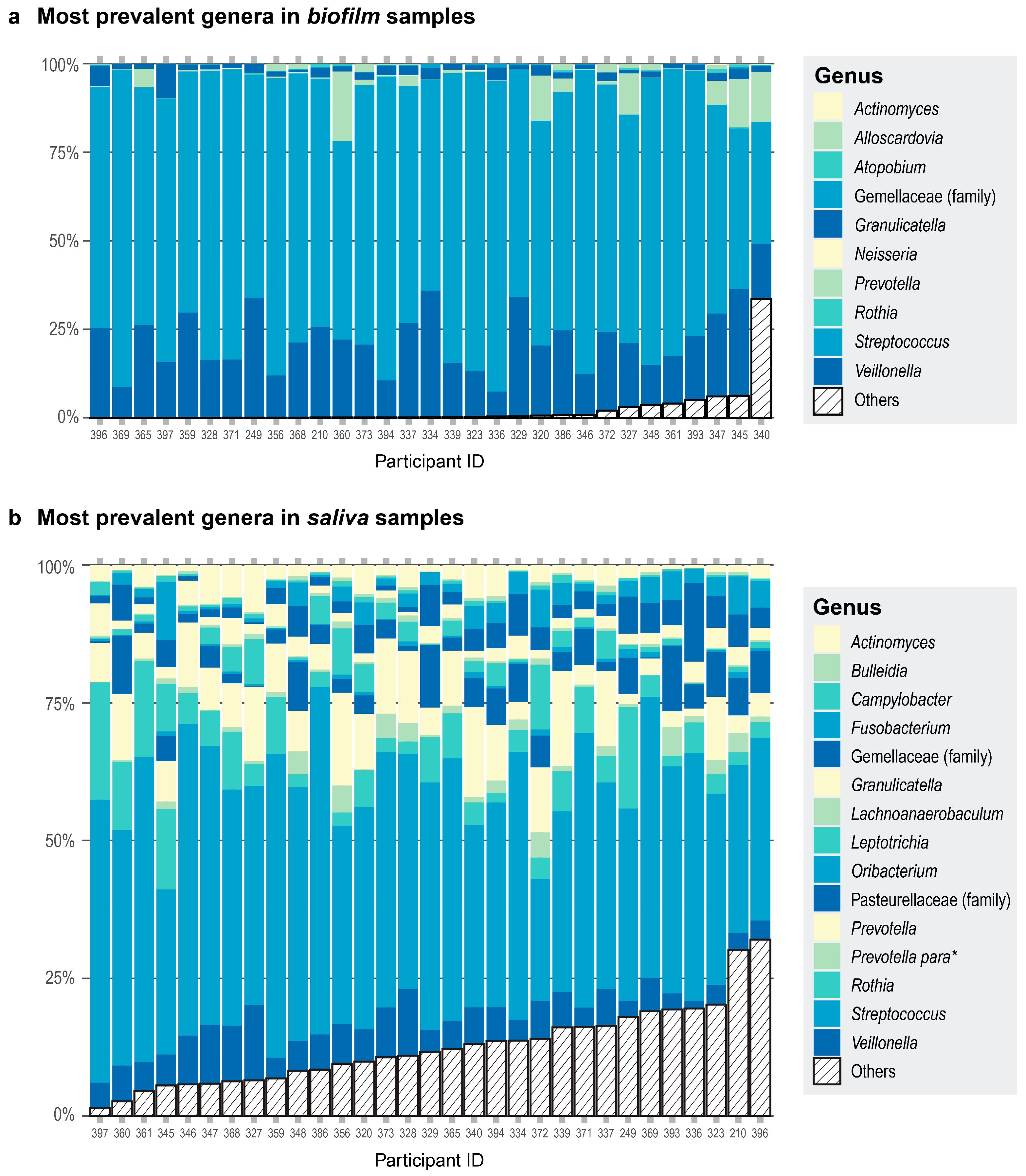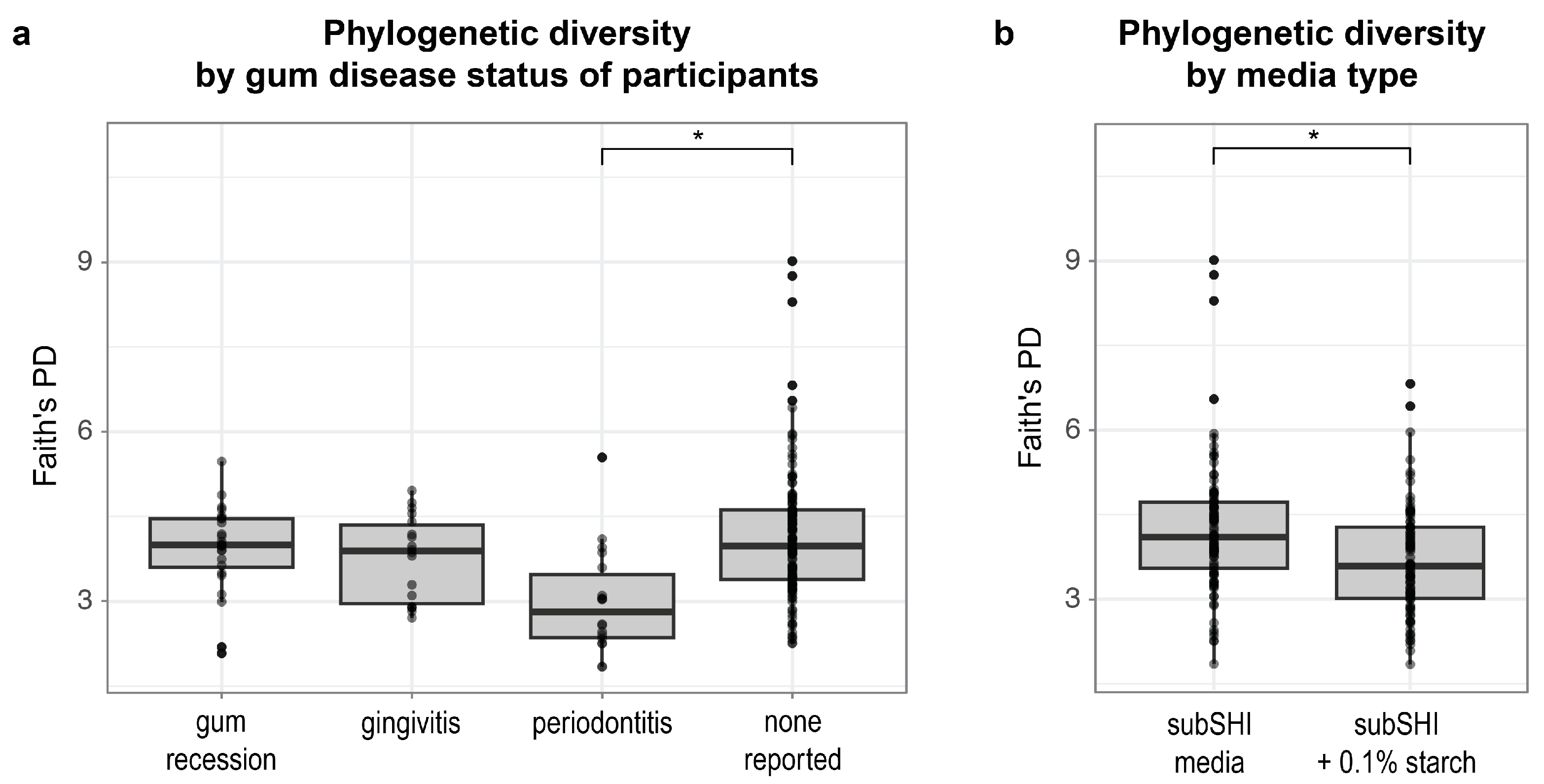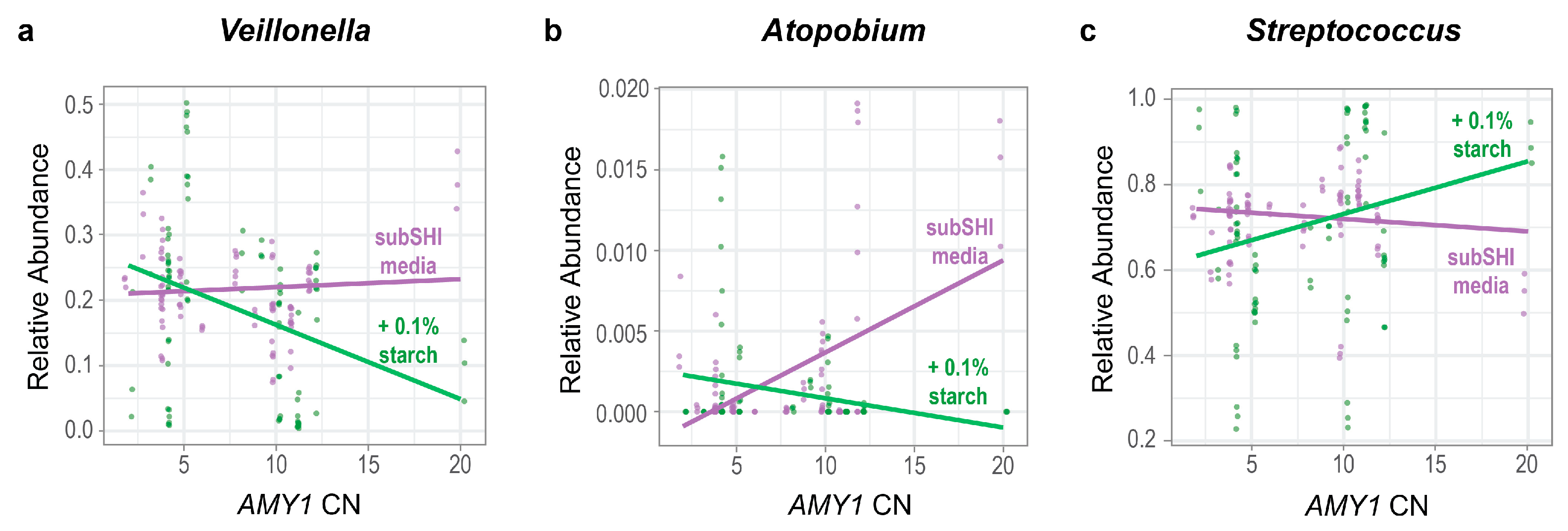The Impact of Human Salivary Amylase Gene Copy Number and Starch on Oral Biofilms
Abstract
:1. Introduction
2. Materials and Methods
2.1. Saliva Collection
2.2. AMY1 Copy Number Determination by Quantitative PCR and Droplet Digital PCR
2.3. Salivary Amylase Activity
2.4. Media
2.5. Biofilm Cultures
2.6. Microbial DNA Extraction and 16S rRNA Sequencing
2.7. Bioinformatics and Statistical Analysis
3. Results
3.1. Characteristics of Saliva Sample Donors
3.2. Biofilm Microbial Communities Differ from Saliva Microbial Communities and Maintain Donor Identity
3.3. Phylogenetic Diversity of Biofilm Cultures Is Predicted by Self-Reported Gum Disease Status and Media
3.4. The Effect of Starch Supplementation on the Relative Abundances of Veillonella and Atopobium in Biofilms Is Modified by AMY1 CN
4. Discussion
5. Conclusions
Supplementary Materials
Author Contributions
Funding
Institutional Review Board Statement
Informed Consent Statement
Data Availability Statement
Acknowledgments
Conflicts of Interest
References
- Halvorsrud, K.; Lewney, J.; Craig, D.; Moynihan, P.J. Effects of Starch on Oral Health: Systematic Review to Inform WHO Guideline. J. Dent. Res. 2019, 98, 46–53. [Google Scholar] [CrossRef] [PubMed]
- Bolognini, D.; Halgren, A.; Lou, R.N.; Raveane, A.; Rocha, J.L.; Guarracino, A.; Soranzo, N.; Chin, C.-S.; Garrison, E.; Sudmant, P.H. Recurrent Evolution and Selection Shape Structural Diversity at the Amylase Locus. Nature 2024, 634, 617–625. [Google Scholar] [CrossRef]
- des Gachons, C.P.; Breslin, P.A.S. Salivary Amylase: Digestion and Metabolic Syndrome. Curr. Diabetes Rep. 2016, 16, 102. [Google Scholar] [CrossRef]
- Nater, U.M.; Rohleder, N.; Schlotz, W.; Ehlert, U.; Kirschbaum, C. Determinants of the Diurnal Course of Salivary Alpha-Amylase. Psychoneuroendocrinology 2007, 32, 392–401. [Google Scholar] [CrossRef] [PubMed]
- Perry, G.H.; Dominy, N.J.; Claw, K.G.; Lee, A.S.; Fiegler, H.; Redon, R.; Werner, J.; Villanea, F.A.; Mountain, J.L.; Misra, R.; et al. Diet and the Evolution of Human Amylase Gene Copy Number Variation. Nat. Genet. 2007, 39, 1256–1260. [Google Scholar] [CrossRef]
- Yılmaz, F.; Karageorgiou, C.; Kim, K.; Pajic, P.; Scheer, K.; Human Genome Structural Variation Consortium; Beck, C.R.; Torregrossa, A.-M.; Lee, C.; Gokcumen, O. Reconstruction of the Human Amylase Locus Reveals Ancient Duplications Seeding Modern-Day Variation. Science 2024, 386, eadn0609. [Google Scholar] [CrossRef] [PubMed]
- About Cavities (Tooth Decay)|Oral Health|CDC. Available online: https://www.cdc.gov/oral-health/about/cavities-tooth-decay.html (accessed on 29 November 2024).
- Sugars and Dental Caries. Available online: https://www.who.int/news-room/fact-sheets/detail/sugars-and-dental-caries (accessed on 29 November 2024).
- Selwitz, R.H.; Ismail, A.I.; Pitts, N.B. Dental Caries. Lancet 2007, 369, 51–59. [Google Scholar] [CrossRef]
- Atkinson, F.S.; Khan, J.H.; Brand-Miller, J.C.; Eberhard, J. The Impact of Carbohydrate Quality on Dental Plaque pH: Does the Glycemic Index of Starchy Foods Matter for Dental Health? Nutrients 2021, 13, 2711. [Google Scholar] [CrossRef] [PubMed]
- Pitts, N.B.; Zero, D.T.; Marsh, P.D.; Ekstrand, K.; Weintraub, J.A.; Ramos-Gomez, F.; Tagami, J.; Twetman, S.; Tsakos, G.; Ismail, A. Dental Caries. Nat. Rev. Dis. Primers 2017, 3, 17030. [Google Scholar] [CrossRef]
- Ribeiro, A.A.; Paster, B.J. Dental Caries and Their Microbiomes in Children: What Do We Do Now? J. Oral Microbiol. 2023, 15, 2198433. [Google Scholar] [CrossRef] [PubMed]
- Stangvaltaite-Mouhat, L.; Pūrienė, A.; Aleksejūnienė, J.; Stankeviciene, I.; Tommeras, B.; Al-Haroni, M. Amylase Alpha 1 Gene (AMY1) Copy Number Variation and Dental Caries Experience: A Pilot Study among Adults in Lithuania. Caries Res. 2021, 55, 174–182. [Google Scholar] [CrossRef]
- Mauricio-Castillo, R.; Valdevit, A.; Gonzalez-Davalos, L.; Dominguez-Perez, R.A.; Garcia-Solis, P.; Vazquez-Martinez, O.; Hernandez-Montiel, H.L.; Solis-Sainz, J.C. Dental Caries Prevalence and Severity Positively Associate with AMY1 Gene Copy Number. Clin. Oral Investig. 2023, 28, 25. [Google Scholar] [CrossRef]
- Culp, D.J.; Robinson, B.; Cash, M.N. Murine Salivary Amylase Protects Against Streptococcus Mutans-Induced Caries. Front. Physiol. 2021, 12, 699104. [Google Scholar] [CrossRef] [PubMed]
- Ahmad, A.; Kumar, D.; Singh, A.; Anand, S.; Agarwal, N.; Ahmad, R. A Comparative Quantitative Assessment of Salivary Iga and Alpha Amylase in Caries Free and Caries Active Children. J. Clin. Pediatr. Dent. 2021, 45, 323–329. [Google Scholar] [CrossRef] [PubMed]
- Borghi, G.N.; Rodrigues, L.P.; Lopes, L.M.; Parisotto, T.M.; Steiner-Oliveira, C.; Nobre-Dos-Santos, M. Relationship among α Amylase and Carbonic Anhydrase VI in Saliva, Visible Biofilm, and Early Childhood Caries: A Longitudinal Study. Int. J. Paediatr. Dent. 2017, 27, 174–182. [Google Scholar] [CrossRef]
- Oral Health. Available online: https://www.who.int/news-room/fact-sheets/detail/oral-health (accessed on 29 November 2024).
- CDC About Periodontal (Gum) Disease. Available online: https://www.cdc.gov/oral-health/about/gum-periodontal-disease.html (accessed on 29 November 2024).
- Nazir, M.; Al-Ansari, A.; Al-Khalifa, K.; Alhareky, M.; Gaffar, B.; Almas, K. Global Prevalence of Periodontal Disease and Lack of Its Surveillance. Sci. World J. 2020, 2020, 2146160. [Google Scholar] [CrossRef] [PubMed]
- Petersen, P.E.; Ogawa, H. The Global Burden of Periodontal Disease: Towards Integration with Chronic Disease Prevention and Control. Periodontology 2000 2012, 60, 15–39. [Google Scholar] [CrossRef]
- Eke, P.I.; Dye, B.A.; Wei, L.; Thornton-Evans, G.O.; Genco, R.J. Prevalence of Periodontitis in Adults in the United States: 2009 and 2010. J. Dent. Res. 2012, 91, 914–920. [Google Scholar] [CrossRef] [PubMed]
- Reddy, M.S.; Geurs, N.C.; Jeffcoat, R.L.; Proskin, H.; Jeffcoat, M.K. Periodontal Disease Progression. J. Periodontol. 2000, 71, 1583–1590. [Google Scholar] [CrossRef]
- Sánchez, G.A.; Miozza, V.; Delgado, A.; Busch, L. Determination of Salivary Levels of Mucin and Amylase in Chronic Periodontitis Patients. J. Periodontal Res. 2011, 46, 221–227. [Google Scholar] [CrossRef]
- Sánchez, G.; Miozza, V.; Delgado, A.; Busch, L. Relationship between Salivary Mucin or Amylase and the Periodontal Status. Oral Dis. 2013, 19, 585–591. [Google Scholar] [CrossRef] [PubMed]
- Vadiati Saberi, B.; Yousefi, F.; Yousefi, T.; Qujeq, D. Assessment of Mucin and Alpha-Amylase Levels in Gingival Crevicular Fluid of Chronic Periodontitis Patients. Oral Dis. 2022, 28, 210–215. [Google Scholar] [CrossRef] [PubMed]
- Hashim, N.T.; Fathima, S.; Hisham, N.M.; Shivappa, P.; Magaogao, M.V.; Islam, M.S.; Ahmed, S.F.; Babiker, R.; Rahman, M.M. Exploring Salivary Alpha-Amylase as a Biomarker in Periodontitis: A Comparative Analysis of Disease Stages and Clinical Correlations. Curr. Issues Mol. Biol. 2024, 46, 12230–12243. [Google Scholar] [CrossRef]
- Sedghi, L.M.; Bacino, M.; Kapila, Y.L. Periodontal Disease: The Good, The Bad, and The Unknown. Front. Cell. Infect. Microbiol. 2021, 11, 766944. [Google Scholar] [CrossRef] [PubMed]
- How, K.Y.; Song, K.P.; Chan, K.G. Porphyromonas Gingivalis: An Overview of Periodontopathic Pathogen below the Gum Line. Front. Microbiol. 2016, 7, 53. [Google Scholar] [CrossRef]
- Lenartova, M.; Tesinska, B.; Janatova, T.; Hrebicek, O.; Mysak, J.; Janata, J.; Najmanova, L. The Oral Microbiome in Periodontal Health. Front. Cell. Infect. Microbiol. 2021, 11, 629723. [Google Scholar] [CrossRef] [PubMed]
- Parlak, H.M.; Buber, E.; Gur, A.T.; Karabulut, E.; Akalin, F.A. Statherin and Alpha-Amylase Levels in Saliva from Patients with Gingivitis and Periodontitis. Arch. Oral Biol. 2023, 145, 105574. [Google Scholar] [CrossRef] [PubMed]
- Poole, A.C.; Goodrich, J.K.; Youngblut, N.D.; Luque, G.G.; Ruaud, A.; Sutter, J.L.; Waters, J.L.; Shi, Q.; El-Hadidi, M.; Johnson, L.M.; et al. Human Salivary Amylase Gene Copy Number Impacts Oral and Gut Microbiomes. Cell Host Microbe 2019, 25, 553–564.e7. [Google Scholar] [CrossRef] [PubMed]
- Lombardo Bedran, T.B.; Marcantonio, R.A.C.; Spin Neto, R.; Alves Mayer, M.P.; Grenier, D.; Spolidorio, L.C.; Spolidorio, D.P. Porphyromonas Endodontalis in Chronic Periodontitis: A Clinical and Microbiological Cross-Sectional Study. J. Oral Microbiol. 2012, 4, 10123. [Google Scholar] [CrossRef]
- Lamont, E.I.; Gadkari, A.; Kerns, K.A.; To, T.T.; Daubert, D.; Kotsakis, G.; Bor, B.; He, X.; McLean, J.S. Modified SHI Medium Supports Growth of a Disease-State Subgingival Polymicrobial Community in Vitro. Mol. Oral Microbiol. 2021, 36, 37–49. [Google Scholar] [CrossRef] [PubMed]
- Tian, Y.; He, X.; Torralba, M.; Yooseph, S.; Nelson, K.E.; Lux, R.; McLean, J.S.; Yu, G.; Shi, W. Using DGGE Profiling to Develop a Novel Culture Medium Suitable for Oral Microbial Communities. Mol. Oral Microbiol. 2010, 25, 357–367. [Google Scholar] [CrossRef] [PubMed]
- Caporaso, J.G.; Lauber, C.L.; Walters, W.A.; Berg-Lyons, D.; Lozupone, C.A.; Turnbaugh, P.J.; Fierer, N.; Knight, R. Global Patterns of 16S rRNA Diversity at a Depth of Millions of Sequences per Sample. Proc. Natl. Acad. Sci. USA 2011, 108, 4516–4522. [Google Scholar] [CrossRef]
- Bolyen, E.; Rideout, J.R.; Dillon, M.R.; Bokulich, N.A.; Abnet, C.C.; Al-Ghalith, G.A.; Alexander, H.; Alm, E.J.; Arumugam, M.; Asnicar, F.; et al. Reproducible, Interactive, Scalable and Extensible Microbiome Data Science Using QIIME 2. Nat. Biotechnol. 2019, 37, 852–857. [Google Scholar] [CrossRef] [PubMed]
- Callahan, B.J.; McMurdie, P.J.; Rosen, M.J.; Han, A.W.; Johnson, A.J.A.; Holmes, S.P. DADA2: High-Resolution Sample Inference from Illumina Amplicon Data. Nat. Methods 2016, 13, 581–583. [Google Scholar] [CrossRef] [PubMed]
- Price, M.N.; Dehal, P.S.; Arkin, A.P. FastTree 2—Approximately Maximum-Likelihood Trees for Large Alignments. PLoS ONE 2010, 5, e9490. [Google Scholar] [CrossRef]
- Bokulich, N.A.; Kaehler, B.D.; Rideout, J.R.; Dillon, M.; Bolyen, E.; Knight, R.; Huttley, G.A.; Gregory Caporaso, J. Optimizing Taxonomic Classification of Marker-Gene Amplicon Sequences with QIIME 2’s Q2-Feature-Classifier Plugin. Microbiome 2018, 6, 90. [Google Scholar] [CrossRef] [PubMed]
- McDonald, D.; Price, M.N.; Goodrich, J.; Nawrocki, E.P.; DeSantis, T.Z.; Probst, A.; Andersen, G.L.; Knight, R.; Hugenholtz, P. An Improved Greengenes Taxonomy with Explicit Ranks for Ecological and Evolutionary Analyses of Bacteria and Archaea. ISME J. 2012, 6, 610–618. [Google Scholar] [CrossRef] [PubMed]
- R Core Team. R: A Language and Environment for Statistical Computing; R Foundation for Statistical Computing: Vienna, Austria, 2022. [Google Scholar]
- Oksanen, J.; Simpson, G.L.; Blanchet, F.G.; Kindt, R.; Legendre, P.; Minchin, P.R.; O’Hara, R.B.; Solymos, P.; Stevens, M.H.H.; Szoecs, E.; et al. Vegan: Community Ecology Package. 2022. Available online: https://cran.r-project.org/web/packages/vegan/vegan.pdf (accessed on 15 February 2025).
- Wells, P.M.; Sprockett, D.D.; Bowyer, R.C.E.; Kurushima, Y.; Relman, D.A.; Williams, F.M.K.; Steves, C.J. Influential Factors of Saliva Microbiota Composition. Sci. Rep. 2022, 12, 18894. [Google Scholar] [CrossRef]
- The Human Microbiome Project Consortium. Structure, Function and Diversity of the Healthy Human Microbiome. Nature 2012, 486, 207–214. [Google Scholar] [CrossRef] [PubMed]
- Zhou, P.; Manoil, D.; Belibasakis, G.N.; Kotsakis, G.A. Veillonellae: Beyond Bridging Species in Oral Biofilm Ecology. Front. Oral Health 2021, 2, 774115. [Google Scholar] [CrossRef] [PubMed]
- Han, M.; Liu, G.; Chen, Y.; Wang, D.; Zhang, Y. Comparative Genomics Uncovers the Genetic Diversity and Characters of Veillonella Atypica and Provides Insights Into Its Potential Applications. Front. Microbiol. 2020, 11, 1219. [Google Scholar] [CrossRef]
- Dame-Teixeira, N.; de Lima, A.K.A.; Do, T.; Stefani, C.M. Meta-Analysis Using NGS Data: The Veillonella Species in Dental Caries. Front. Oral Health 2021, 2, 770917. [Google Scholar] [CrossRef] [PubMed]
- Hoare, A.; Wang, H.; Meethil, A.; Abusleme, L.; Hong, B.-Y.; Moutsopoulos, N.M.; Marsh, P.D.; Hajishengallis, G.; Diaz, P.I. A Cross-Species Interaction with a Symbiotic Commensal Enables Cell-Density-Dependent Growth and in Vivo Virulence of an Oral Pathogen. ISME J. 2021, 15, 1490–1504. [Google Scholar] [CrossRef]
- Davey, M.E. Techniques for the Growth of Porphyromonas Gingivalis Biofilms. Periodontology 2000 2006, 42, 27–35. [Google Scholar] [CrossRef]
- Tan, K.H.; Seers, C.A.; Dashper, S.G.; Mitchell, H.L.; Pyke, J.S.; Meuric, V.; Slakeski, N.; Cleal, S.M.; Chambers, J.L.; McConville, M.J.; et al. Porphyromonas Gingivalis and Treponema Denticola Exhibit Metabolic Symbioses. PLOS Pathog. 2014, 10, e1003955. [Google Scholar] [CrossRef] [PubMed]
- Aas, J.A.; Griffen, A.L.; Dardis, S.R.; Lee, A.M.; Olsen, I.; Dewhirst, F.E.; Leys, E.J.; Paster, B.J. Bacteria of Dental Caries in Primary and Permanent Teeth in Children and Young Adults. J. Clin. Microbiol. 2008, 46, 1407–1417. [Google Scholar] [CrossRef] [PubMed]
- Xu, L.; Chen, X.; Wang, Y.; Jiang, W.; Wang, S.; Ling, Z.; Chen, H. Dynamic Alterations in Salivary Microbiota Related to Dental Caries and Age in Preschool Children With Deciduous Dentition: A 2-Year Follow-Up Study. Front. Physiol. 2018, 9, 342. [Google Scholar] [CrossRef]
- Kalpana, B.; Prabhu, P.; Bhat, A.H.; Senthilkumar, A.; Arun, R.P.; Asokan, S.; Gunthe, S.S.; Verma, R.S. Bacterial Diversity and Functional Analysis of Severe Early Childhood Caries and Recurrence in India. Sci. Rep. 2020, 10, 21248. [Google Scholar] [CrossRef]
- Kianoush, N.; Adler, C.J.; Nguyen, K.-A.T.; Browne, G.V.; Simonian, M.; Hunter, N. Bacterial Profile of Dentine Caries and the Impact of pH on Bacterial Population Diversity. PLoS ONE 2014, 9, e92940. [Google Scholar] [CrossRef] [PubMed]
- Flint, H.J.; Scott, K.P.; Duncan, S.H.; Louis, P.; Forano, E. Microbial Degradation of Complex Carbohydrates in the Gut. Gut Microbes 2012, 3, 289–306. [Google Scholar] [CrossRef]
- Zheng, J.; Hu, B.; Zhang, X.; Ge, Q.; Yan, Y.; Akresi, J.; Piyush, V.; Huang, L.; Yin, Y. dbCAN-Seq Update: CAZyme Gene Clusters and Substrates in Microbiomes. Nucleic Acids Res. 2023, 51, D557–D563. [Google Scholar] [CrossRef] [PubMed]
- Abranches, J.; Zeng, L.; Kajfasz, J.K.; Palmer, S.R.; Chakraborty, B.; Wen, Z.T.; Richards, V.P.; Brady, L.J.; Lemos, J.A. Biology of Oral Streptococci. Microbiol. Spectr. 2018, 6, 1–12. [Google Scholar] [CrossRef] [PubMed]
- Kilian, M.; Nyvad, B. Ability to Bind Salivary Alpha-Amylase Discriminates Certain Viridans Group Streptococcal Species. J. Clin. Microbiol. 1990, 28, 2576–2577. [Google Scholar] [CrossRef]
- Hamada, S.; Slade, H.D. Biology, Immunology, and Cariogenicity of Streptococcus Mutans. Microbiol. Rev. 1980, 44, 331–384. [Google Scholar] [CrossRef] [PubMed]
- Li, Z.-R.; Sun, J.; Du, Y.; Pan, A.; Zeng, L.; Maboudian, R.; Burne, R.A.; Qian, P.-Y.; Zhang, W. Mutanofactin Promotes Adhesion and Biofilm Formation of Cariogenic Streptococcus Mutans. Nat. Chem. Biol. 2021, 17, 576–584. [Google Scholar] [CrossRef]
- Rogers, J.D.; Palmer, R.J.; Kolenbrander, P.E.; Scannapieco, F.A. Role of Streptococcus Gordonii Amylase-Binding Protein A in Adhesion to Hydroxyapatite, Starch Metabolism, and Biofilm Formation. Infect. Immun. 2001, 69, 7046–7056. [Google Scholar] [CrossRef]
- Kreth, J.; Giacaman, R.A.; Raghavan, R.; Merritt, J. The Road Less Traveled—Defining Molecular Commensalism with Streptococcus Sanguinis. Mol. Oral Microbiol. 2017, 32, 181–196. [Google Scholar] [CrossRef]
- Díaz-Garrido, N.; Lozano, C.P.; Kreth, J.; Giacaman, R.A. Competition and Caries on Enamel of a Dual-Species Biofilm Model with Streptococcus Mutans and Streptococcus Sanguinis. Appl. Environ. Microbiol. 2020, 86, e01262-20. [Google Scholar] [CrossRef]
- Chen, H.; Liu, Y.; Zhang, M.; Wang, G.; Qi, Z.; Bridgewater, L.; Zhao, L.; Tang, Z.; Pang, X. A Filifactor Alocis-Centered Co-Occurrence Group Associates with Periodontitis across Different Oral Habitats. Sci. Rep. 2015, 5, 9053. [Google Scholar] [CrossRef]
- Ai, D.; Huang, R.; Wen, J.; Li, C.; Zhu, J.; Xia, L.C. Integrated Metagenomic Data Analysis Demonstrates That a Loss of Diversity in Oral Microbiota Is Associated with Periodontitis. BMC Genom. 2017, 18, 1041. [Google Scholar] [CrossRef] [PubMed]
- Malcangi, G.; Patano, A.; Guglielmo, M.; Sardano, R.; Palmieri, G.; Di Pede, C.; de Ruvo, E.; Inchingolo, A.D.; Mancini, A.; Inchingolo, F.; et al. Precision Medicine in Oral Health and Diseases: A Systematic Review. J. Pers. Med. 2023, 13, 725. [Google Scholar] [CrossRef] [PubMed]
- Papale, F.; Santonocito, S.; Polizzi, A.; Giudice, A.L.; Capodiferro, S.; Favia, G.; Isola, G. The New Era of Salivaomics in Dentistry: Frontiers and Facts in the Early Diagnosis and Prevention of Oral Diseases and Cancer. Metabolites 2022, 12, 638. [Google Scholar] [CrossRef]




| Total n | 31 |
| Age in years (Mean ± SD) | 19–57 (29.5 ± 9) |
| Sex | |
| Female | 25 (81%) |
| Male | 6 (19%) |
| Gum disease status (self-reported) | |
| Gingivitis | 3 (9.7%) |
| Gum recession | 4 (12.9%) |
| Periodontitis | 4 (12.9%) |
| None | 20 (64.5%) |
| Prevalence | Taxonomy | Gum Disease | Age | AMY1 CN | Media | AMY1 CN × Media |
|---|---|---|---|---|---|---|
| 1 | Streptococcus | 0.77 | 0.038 | 0.62 | 0.079 | 0.078 |
| 1 | Veillonella | 0.42 | 0.38 | 0.21 | 0.17 | 0.038 |
| 1 | Granulicatella | 0.025 | 0.89 | 0.27 | <0.0001 | 0.97 |
| 4 | Gemellaceae | 0.35 | 0.73 | 0.84 | 0.0097 | 0.28 |
| 5 | Prevotella | 0.52 | 0.0030 | 0.93 | 0.10 | 0.65 |
| 6 | Neisseria | 0.45 | 0.71 | 0.13 | 0.16 | 0.43 |
| 7 | Rothia | 0.43 | 0.48 | 0.33 | 0.49 | 0.81 |
| 8 | Atopobium | 0.18 | 0.0015 | 0.023 | 0.016 | 0.0013 |
| 9 | Actinomyces | 0.38 | 0.022 | 0.63 | 0.99 | 0.49 |
| 10 | Alloscardovia | 0.89 | 0.52 | 0.60 | 0.032 | 0.29 |
Disclaimer/Publisher’s Note: The statements, opinions and data contained in all publications are solely those of the individual author(s) and contributor(s) and not of MDPI and/or the editor(s). MDPI and/or the editor(s) disclaim responsibility for any injury to people or property resulting from any ideas, methods, instructions or products referred to in the content. |
© 2025 by the authors. Licensee MDPI, Basel, Switzerland. This article is an open access article distributed under the terms and conditions of the Creative Commons Attribution (CC BY) license (https://creativecommons.org/licenses/by/4.0/).
Share and Cite
Superdock, D.K.; Johnson, L.M.; Ren, J.; Khan, A.; Eno, M.; Man, S.; Poole, A.C. The Impact of Human Salivary Amylase Gene Copy Number and Starch on Oral Biofilms. Microorganisms 2025, 13, 461. https://doi.org/10.3390/microorganisms13020461
Superdock DK, Johnson LM, Ren J, Khan A, Eno M, Man S, Poole AC. The Impact of Human Salivary Amylase Gene Copy Number and Starch on Oral Biofilms. Microorganisms. 2025; 13(2):461. https://doi.org/10.3390/microorganisms13020461
Chicago/Turabian StyleSuperdock, Dorothy K., Lynn M. Johnson, Jennifer Ren, Alizeh Khan, Megan Eno, Shuai Man, and Angela C. Poole. 2025. "The Impact of Human Salivary Amylase Gene Copy Number and Starch on Oral Biofilms" Microorganisms 13, no. 2: 461. https://doi.org/10.3390/microorganisms13020461
APA StyleSuperdock, D. K., Johnson, L. M., Ren, J., Khan, A., Eno, M., Man, S., & Poole, A. C. (2025). The Impact of Human Salivary Amylase Gene Copy Number and Starch on Oral Biofilms. Microorganisms, 13(2), 461. https://doi.org/10.3390/microorganisms13020461






